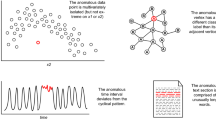Abstract
In Knowledge Discovery in Databases (KDD)/Data Mining literature, “interestingness” measures are used to rank rules according to the “interest” a particular rule is expected to evoke. In this paper, we introduce an aspect of subjective interestingness called “item-relatedness”. Relatedness is a consequence of relationships that exist between items in a domain. Association rules containing unrelated or weakly related items are interesting since the co-occurrence of such items is unexpected. ‘Item-Relatedness’ helps in ranking association rules on the basis of one kind of subjective unexpectedness. We identify three types of item-relatedness – captured in the structure of a “fuzzy taxonomy” (an extension of the classical concept hierarchy tree). An “item-relatedness” measure for describing relatedness between two items is developed by combining these three types. Efficacy of this measure is illustrated with the help of a sample taxonomy. We discuss three mechanisms for extending this measure from a two-item set to an association rule consisting of a set of more than two items. These mechanisms utilize the relatedness of item-pairs and other aspects of an association rule, namely its structure, distribution of items and item-pairs. We compare our approach with another method from recent literature.
Similar content being viewed by others
References
Adomavicius, G. and A. Tuzhilin. (1997). “Discovery of Actionable Patterns in Databases: The Action Hierarchy Approach'', In Proceedings of KDD-1997, AAAI.
Agirre, E. and G. Rigau. (1996). “Word Sense Disambiguation using Conceptual Density'', In Proceedings of COLING 1996.
Basu, S., R. J. Mooney, K. V. Pasupuleti, and J. Ghosh. (2001). “Evaluating the Novelty of Text-Mined Rules Using Lexical Knowledge,” In Proceedings of the Seventh International Conference on Knowledge Discovery and Data Mining (KDD 2001).
Bayardo Jr., R. J., R. Agrawal, and D. Gunopulos. (2000). “Constraint-Based Rule Mining in Large, Dense Databases,” Data Mining and Knowledge Discovery 4(2/3), 217–240.
Chen, G., G. Wets, and K. Vanhoof. (2000). “Representation and Discovery of Fuzzy Association Rules (FARs)'', Institute of applied Economic Research (ITEO), Limburg University Centre (LUC), Belgium, Research Paper Series, ITEO No: 00/01.
de Graaf, J. M., W. A. Kosters, and J. J. W. Witteman. (2001). “Interesting Fuzzy Association Rules in Quantitative Databases,” In L. De Raedt and A. Siebes (eds.), Proceedings of PKDD 2001 (The 5th European Conference on Principles of Data Mining and Knowledge Discovery), Springer Lecture Notes in Artificial Intelligence 2168, 140-151.
de Graaf, J. M., W. A. Kosters, and J. J. W. Witteman. (2000). “Interesting Association Rules in Multiple Taxonomies'', In A. van den Bosch and H. Weigand (eds.),Proceedings of BNAIC'00, Kaatsheuvel, 93-100.
Deo, N. (1989). Graph Theory with Applications to Engineering and Computer Science. Prentice Hall of India Private Limited.
Dong, G. and J. Li. (1998). “Interestingness of Discovered Association Rules in Terms of Neighborhood-Based Unexpectedness,” In Proceedings of the Second Pacific-Asia Conference on Knowledge Discovery and Data Mining, 72-86.
Freitas, A. A. (1999). “On Rule Interestingness Measures,” Knowledge-Based Systems 12, 309–315.
Hamilton, H. J. and D. R. Fudger. (1995). “Estimating DBLEARN's Potential for Knowledge Discovery in Databases,” Computational Intelligence 11(2), 280–296.
Hilderman, R. J. and H. J. Hamilton. (1999). “Knowledge Discovery and Interestingness Measures: A Survey,” Technical Report, Department of Computer Science, University of Regina, Canada.
Hussain, F., H. Liu, E. Suzuki, and H. Lu. (2000). “Exception Rule Mining with a Relative Interestingness Measure,” In Proceedings of Pacific Asia Conference on Knowledge Discovery in Databases (PAKDD 2000), 86-97.
Klemettinen, M., H. Mannila, P. Ronkainen, H. Toivonen, and I. A. Verkamo. (1994). “Finding Interesting Rules from Large sets of Discovered Association Rules,” In N. R. Adam, B. K. Bhargava, and Y. Yesha, (eds.), Proceedings of the Third International Conference on Information and Knowledge Management (CIKM'94). ACM Press, 401-407.
Klir, G. J. and B. Yuan. (1997). Fuzzy Sets and Fuzzy Logic: Theory and Applications. New Delhi: Prentice Hall of India Private Limited.
Lin, D. and P. Pantel. (2002). “Concept Discovery from Text,” In Proceedings of Conference on Computational Linguistics.
Liu, B., W. Hsu, L. Mun, and H. Lee. (1999). "Finding Interesting Patterns Using User Expectations,” IEEE Transactions on Knowledge and Data Engineering 11(6), 817–832.
Liu, B., W. Hsu, S. Chen, and Y. Ma. (2000). “Analyzing the Subjective Interestingness of Association Rules,” IEEE Intelligent Systems 15(5), 47–55.
Padmanabhan, B. and A. Tuzhilin. (1999). “Unexpectedness as a Measure of Interestingness in Knowledge Discovery,” Decision Support Systems 27(3), 303–318.
Pantel P. and D. Lin. (2002). “Discovering Word Senses from Text,” In Proceedings of the ACM SIG conference on Knowledge Discovery and Data Mining.
Resnik, P. (1999). “Semantic Similarity in a Taxonomy: An Information-Based Measure and Its Application to Problems of Ambiguity in Natural Language,” Journal of Artificial Intelligence Research (JAIR) 11, 95–130.
Silberschatz, A. and A. Tuzhilin. (1996). “What makes Patterns Interesting in Knowledge Discovery Systems,” IEEE Transactions on Knowledge and Data Engineering 8(6), 970–974.
Srikant, R. and R. Agrawal. (1995). “Mining Generalized Association Rules,” In Proceedings of the 21st VLDB conference, 407-419.
Subramanian, D. K., V. S. Ananthanarayana, and M. Narasimha Murty. (2003). “Knowledge-Based Association Rule Mining using AND-OR taxonomies,” Knowledge-Based Systems 16, 37–45.
Tan, P., V. Kumar, and J. Srivastava. (2002). “Selecting the Right Interestingness Measure for Association Patterns,” In Proceedings of the Eighth ACM SIGKDD Int'l Conf. on Knowledge Discovery and Data Mining (KDD-2002).
Author information
Authors and Affiliations
Rights and permissions
About this article
Cite this article
Shekar, B., Natarajan, R. A Framework for Evaluating Knowledge-Based Interestingness of Association Rules. Fuzzy Optimization and Decision Making 3, 157–185 (2004). https://doi.org/10.1023/B:FODM.0000022043.43885.55
Issue Date:
DOI: https://doi.org/10.1023/B:FODM.0000022043.43885.55




